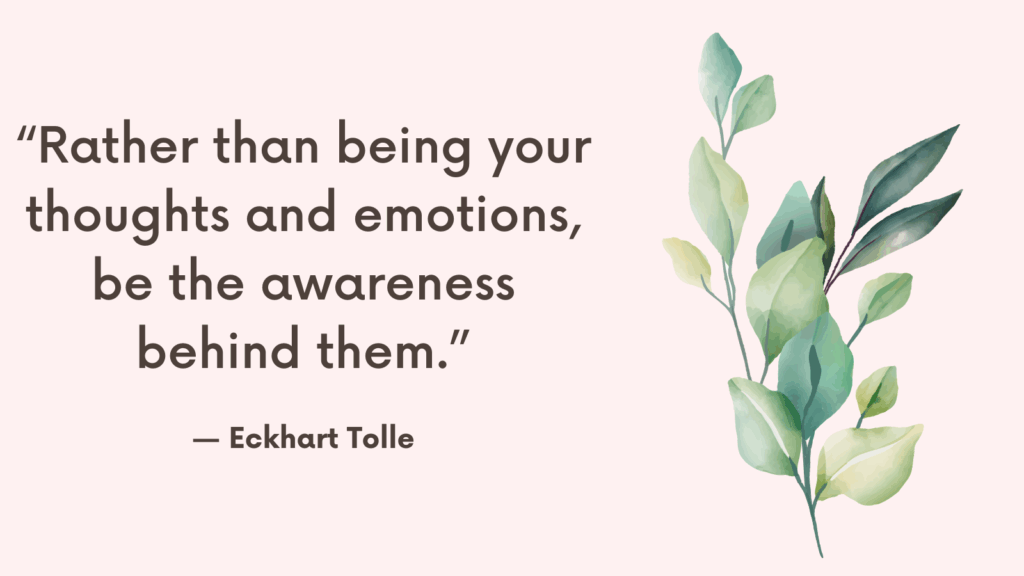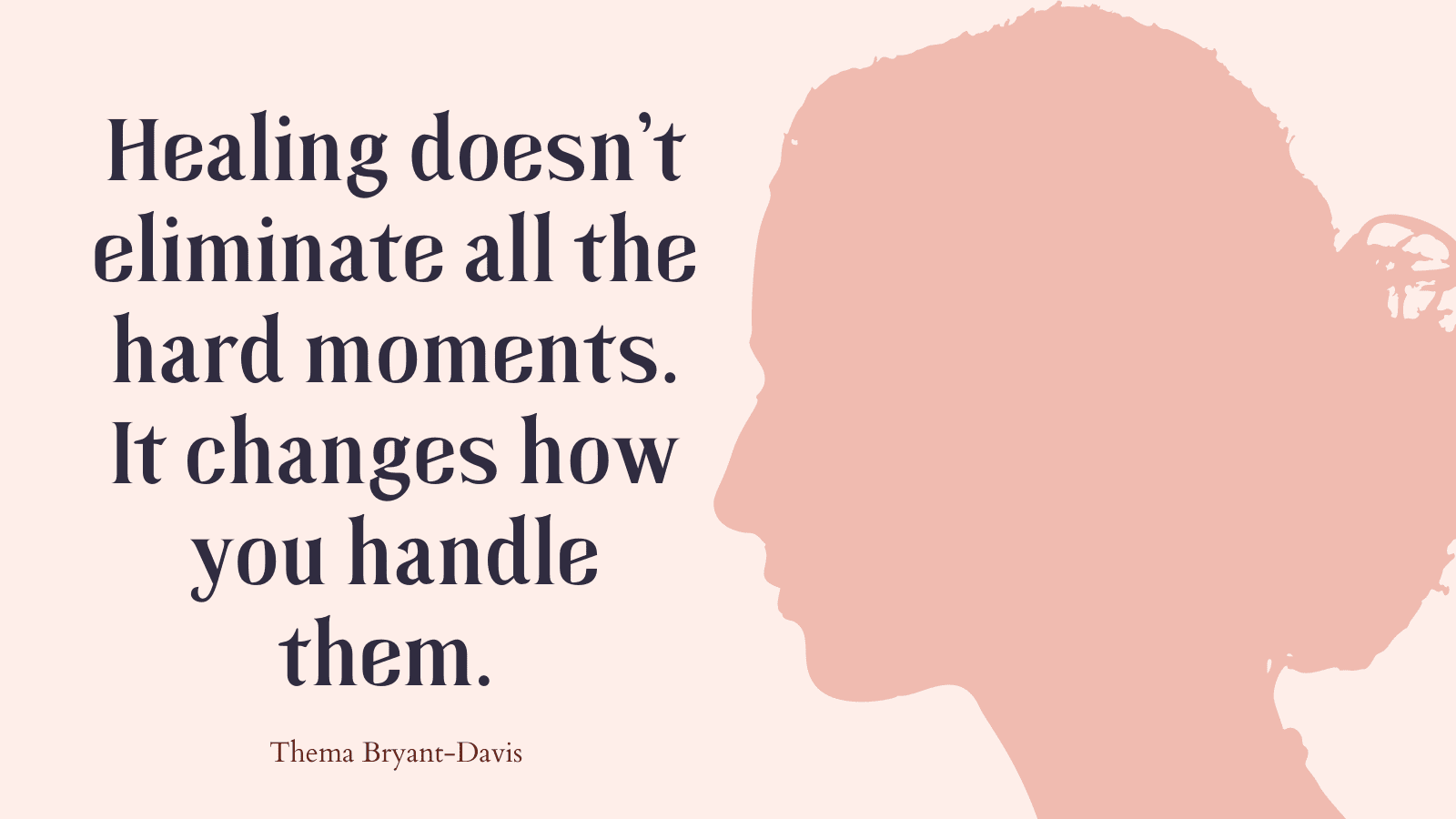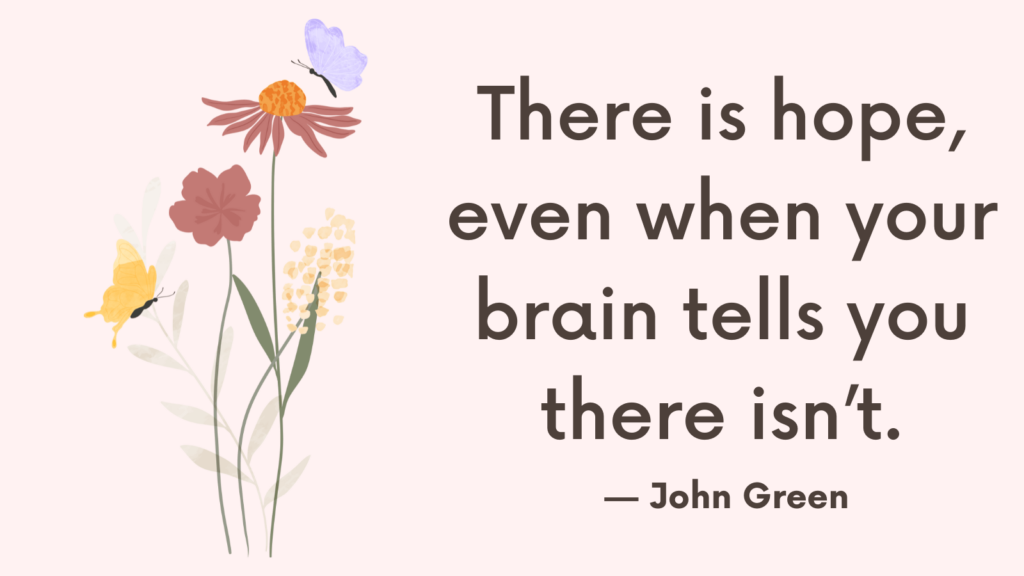Today, you’re going to learn the difference between pain and suffering and how to embrace the pain, deal with suffering in your life, and start enjoying your life.
Pain is a natural, inevitable part of being human.
There are always going to be situations in your life that will cause you pain: the death of a loved one, disappointments, and every other difficult emotion you can think of.
Suffering happens when you don’t accept the pain in your life – when you spend so much of your time and energy trying to deny the reality that’s causing the pain.
You don’t just feel grief for losing someone you love, you also feel anger, despair, bitterness, and other secondary emotions (emotional reactions you have to other emotions).
Pain vs Suffering
In Buddhism, “pain” refers to the initial physical or emotional sensation that we feel in response to a stimulus, which is a healthy and evolutionarily adaptive response.
“Suffering,” on the other hand, refers to everything that comes after the initial injury.
Suffering is something we ourselves create.
It is caused by our response or reaction to our pain, rather than by the pain itself.
In the lesson, which has been translated from the SallathaSutta, the Buddha teaches this:
“When touched with a feeling of pain, the uninstructed run-of-the-mill person sorrows, grieves, and laments, beats his breast, becomes distraught. So he feels 2 pains: physical and mental. Just as if they were to shoot a man with an arrow and, right afterward, were to shoot him with another one, so that he would feel the pains of 2 arrows…As he is touched by that painful feeling, he is resistant…Sensing a feeling of pain, he senses it as though joined with it…He is joined, I tell you, with suffering and stress.
Now, the well-instructed disciple of the noble ones, when touched with a feeling of pain, does not sorrow, grieve, or lament, does not beat his breast or become distraught. So he feels 1 pain: physical, but not mental. Just as if they were to shoot a man with an arrow and, right afterward, did not shoot him with another 1, so that he would feel the pain of only one arrow…He feels one pain: physical, but not mental.”
— THE TEACHINGS OF THE BUDDHA, SALLATHA SUTTA
Related: Top 21 Emotional Writing Prompts To Process Emotions
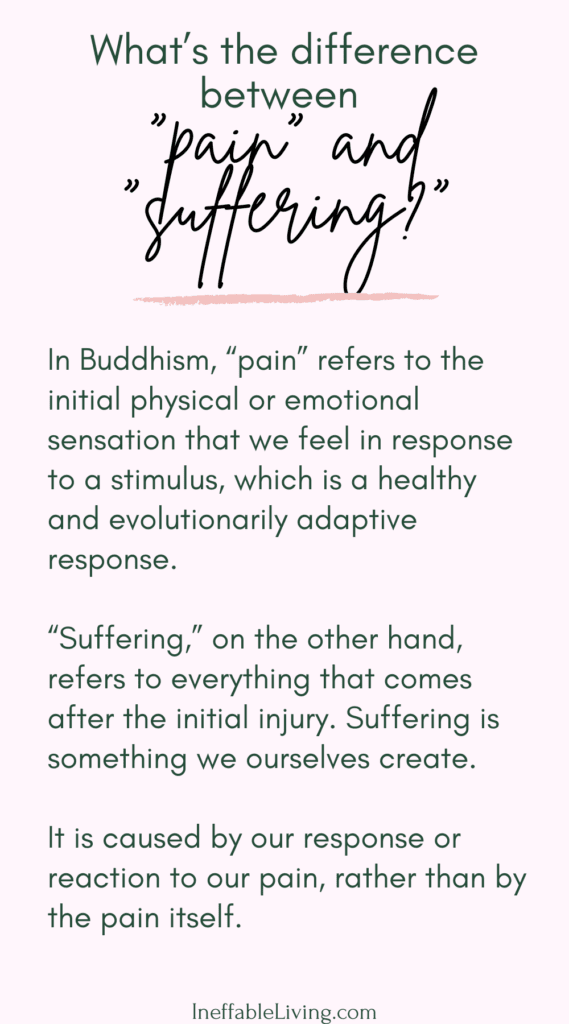
How Pain Becomes Suffering
In the same way physical pain can motivate you to seek help with any health problems, emotional alerts you and motivates you to take action to address underlying issues.
If you do something about your pain, or merely think about doing them, the pain subsides.
If you don’t, the alarm of pain intensifies and generalizes and we suffer.
Related: Best 99 Coping Skills (+FREE Coping Worksheets)
What are the Five Signs of Emotional Suffering?
The Campaign to Change Direction outlines the 5 Signs of Emotional Suffering to detect in someone else, but you can use them to check in with yourself:
- Personality changes in a way that seems different for you or doesn’t fit your values.
- Agitation or experiencing anger, anxiety or moodiness while finding it difficult to calm down or control your temper.
- Withdrawal or isolation from others
- Poor self-care and perhaps engaging in risky behavior, such as abusing alcohol or illicit substances or engaging in other self-destructive behavior
- Feelings of Hopelessness, worthlessness, or feelings of being overwhelmed
Related: Best Edith Eger Quotes (“The Gift”): 12 Invaluable Lessons to Set Yourself Free
Suffering Is Optional Pain Is Inevitable: 4 Tips On How to Overcome Your Suffering
#1. Practice Self-Compassion
Self-compassion can be learned and developed. Practicing self-compassion when you make mistakes helps reduce your suffering.
Dr. Kristin Neff, an expert on self-compassion, has identified 3 main components for healthy self-respect and self-acceptance: “self-kindness rather than self-judgment; common humanity rather than isolation; and mindfulness rather than over-identification.”
1. Self-kindness
Self-kindness refers to graciously recognizing and accepting your own suffering. It means overcoming the harsh judgments of your inner critic and using a soft and loving tone with yourself.
To practice self-kindness, think about what you would tell a dear friend who is living through a difficult and trying experience and say it to yourself.
This type of kindness has a soothing and warm nature—similar to the way you might treat a dear friend who is living through a difficult and trying experience.
2. Recognizing common humanity
Recognizing common humanity means acknowledging the shared human experiences of pain and suffering.
This helps you feel less alone in your own suffering and more like you are part of a broader community of humans who all suffer at one time or another.
You come to accept that all humans have flaws and make mistakes, but that brings us together rather than isolates us.
Related: How To Be Gentle With Yourself? Top 5 Ways To Practice Self-Compassion
3. Mindfulness
Mindfulness refers to the ability to fully experience the present moment—whether it is a joyful or painful one.
That doesn’t mean allowing emotions to overwhelm you, but simply acknowledging that these emotions are there and that they are part of our own human experience, but more importantly that they are fleeting.
Mindfulness means you experience these emotions without incorporating them into your identity.
#2. Practice Radical Acceptance
Fighting Reality
As humans, our natural instinct is to avoid pain, be it physical or emotional.
So it is understandable that when we experience pain, our automatic response would be to fight it. Part of us might believe that if we deny the pain long enough, it will go away.
You might find yourself thinking, “Why me?” or, “This isn’t fair. I shouldn’t have to go through this.”
But fighting our emotions doesn’t make the pain go away, it intensifies. It creates secondary emotions (emotional reactions you have to other emotions) such as anger, frustration, bitterness, or resentment.
Fighting reality creates suffering.
What Should You Do Instead?
Begin to accept and validate your emotions and experiences.
This doesn’t mean that you like it that way or that you do nothing to change it.
In fact, acceptance is nonjudgmental. When you accept something, you’re not saying it’s good or bad. You’re simply acknowledging reality as it is. You can dislike something and still accept it.
And it is only when you accept something that you can change it. When you spend so much of your time and energy feeling frustrated and self-pitying yourself for the reality of a situation, you have little time or energy left to actually do something that will change that situation.
Related: Best 18 Self Compassion Journal Prompts (+FREE Worksheets)
Is The Word “Acceptance” Off-Putting?
If you can’t get past the word “acceptance,” replace it with other words, like “acknowledgment,” or, “validating your experience.”
You can also repeat phrases to yourself, like:
- “I don’t like it, but it is what it is.”
- “This is the way things are now.”
- “I acknowledge that this is the reality of my life now.”
How to Practice Radical Acceptance?
Radical acceptance is not a skill that you can accomplish overnight.
The more painful the situation, the longer it’ll take for you to accept it. You may also get to the point of acceptance, only to have something happens that gets you fighting reality again. This is natural.
Think of that little time you felt acceptance, even if it was for a few minutes each day, as a time of not suffering – you’ve decreased your painful emotions and made life more tolerable and that’s the goal.
With practice and gradually that time will increase until you’ve fully accepted it.
Related: Top 10 Ways To Stop Wallowing In Self Pity
5 Steps to Radically Accept a Situation
- Make a list of situations you want to accept.
- Rate the intensity of the pain of each situation on a scale from 1 to 10, where 1 is very little pain, and 10 is highly intense.
- Identify the least pain-triggering situation and start trying to practice radical acceptance with it.
- Notice when you start fighting reality again.
- Turn your mind back to acceptance
Radical Acceptance FAQ
“If I Radically Accept, Does It Mean That I’m Giving Up?”
Radically accepting doesn’t mean you have to become passive about the situation. It doesn’t mean that you shouldn’t do anything to change the situation.
Radical acceptance means feeling the pain without resisting it – you stop fighting reality. So you end up with more energy and time to think of your next action.
You think to yourself, “Okay, I acknowledge the reality that I’m having a depressive episode. Now what can I do that will be most helpful?”
“How Can I Accept That I Will Have to Experience Pain for the Rest of My Life?”
You can’t accept things that didn’t happen yet.
Radically accepting pain means only accepting it at the present time – it has nothing to do with experiencing pain in the future.
“Some Things Are Just Too Awful to Accept”
Unfortunately, even when you don’t want to go there, your mind has a painful tendency to bring these things back over and over again. Radical acceptance can reduce that pain and help you to think about a painful situation less.
Acceptance doesn’t mean that you approve of the situation or that you forgive the person who hurt you.
Remind yourself that you’re practicing radical acceptance for yourself.
Related: Top +100 Journal Prompts For Mental Health [+Free PDF Printable!]
#3. Find The Silver Lining
1. Look For “What’s Good About” Your Feeling
It can be extremely difficult to think about “what’s good about” your pain.
But acknowledging the good thing about pain can help reduce your suffering.
As with radical acceptance, finding the silver lining doesn’t mean that you like the way you feel or that you won’t be able to change it. It simply means that you’re not wasting any more of your time and energy fighting reality, and are choosing to see your pain as an opportunity you can use to grow.
Related: Top 21 Healing Journal Prompts To Support Your Healing Journey
Practical Exercise – “What’s Good About How You’re Feeling?”
If you are, for example, feeling afraid, anticipating an upcoming challenge, try to think of what’s good about this fear.
Your list might go like this:
- “This uncomfortable feeling is nudging me to challenge myself and is forcing me to discover my power.”
- “Considering that I’m not used to doing this, I should be feeling this way, and anyone in a similar situation would feel this way.”
- “This is a practice that will help me grow as a person and be able to face harder things in the future.”
- “This intense feeling shows that I care.”
2. Supercharge Your Way to The Gains
Every challenge is an opportunity to grow as a person and hugely benefit your life.
That’s why, you don’t just want to accept these challenges, you want to actually choose them.
Practical Exercise – Look For The Corresponding Gains
In your journal, write on the left-hand side “challenge” and on the right-hand side “gains”
Under the “challenge” heading, you are going to list those painful feelings or situations you are experiencing at the moment.
These could include longstanding issues, such as chronic pain, an ongoing battle with anxiety or depression, or it could be a current feeling.
Once you’ve finished your list of challenges, under the “gains” heading, write the exact opposite, asking yourself as you do so, “What is this challenge can produce if I face it?”
You don’t have to feel these feelings, you just have to do the task of writing them down.
For example:
| Challenges | Gains |
| Fear Worry Arguments Boredom Not liking my job Feeling weak | Fearlessness Trust, optimism Great relationships Passion, enthusiasm Finding a career I love Feeling strong, confident |
Keep in mind that the faster you embrace these challenges, the faster you’ll get to the gains.
#4. Gratitude
1. What Makes You Eligible?
Gratitude should extend to yourself too.
Ask yourself, “What makes me eligible?” And write your answers down.
These could include:
- Having an interesting job
- Having beautiful eyes
- Having a healthy body
- Having a good taste in clothes
For some people, these types of appreciation might seem shallow. But this is your first step to hold your attention and pull yourself out of negative beliefs about yourself – which are anything but shallow.
2. Renew Your Appreciation for People, Places, and Things
As humans, we get used to things quickly.
This is what psychologists call ‘hedonic adaptation.’
For example, you may get a new outfit that you feel great in, only to get used to it and stop feeling as good wearing it.
That’s why we need to constantly renew our appreciation for people, places, and things.
Practical Exercise – Renew Your Appreciation
Start by going over your wardrobe. Look at the items that once thrilled you and remind yourself of these feelings.
Then go over the gadgets you have in your house and do the same.
Move on to your loved ones. Imagine how life would feel without them and allow yourself to feel appreciation for having them in your life.
Read More: Daily Gratitude Ideas: 10 Ways to Practice Gratitude Every Day
Conclusion
Everyone is fighting inner battles. But no one likes to show this inner life, because we don’t feel like it is attractive. That’s not being inauthentic – it’s understandable.
So know that you’re not alone in this.
Many people force themselves to be positive, no matter what’s going on in their lives. But loving yourself means loving all parts of yourself, even the times when you are not feeling confident.
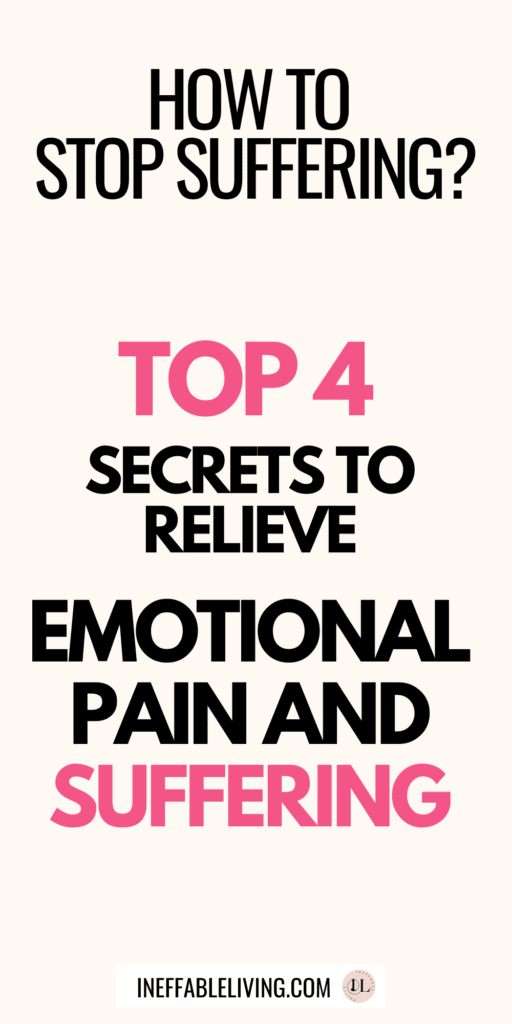
Resources
- Portions of this article were adapted from the book 365 Ways to Beat How to Relax & Find Perfect Calm, © 2019 by Adam Gordon. All rights reserved.
- Portions of this article were adapted from the book The Dialectical Behavior Therapy Skills Workbook for Bipolar Disorder: Using DBT to Regain Control of Your Emotions and Your Life, © 2009 by Sheri Van Dijk. All rights reserved.
- Portions of this article were adapted from the book Feel Better, No Matter What, © 2021 by Michael James. All rights reserved.
- Pain and Emotion: A Biopsychosocial Review of Recent Research – PMC (nih.gov)
- Emotional pain and suffering: The search for global solutions. – PsycNET (apa.org)
- Conceptualizing suffering and pain – PMC (nih.gov)
